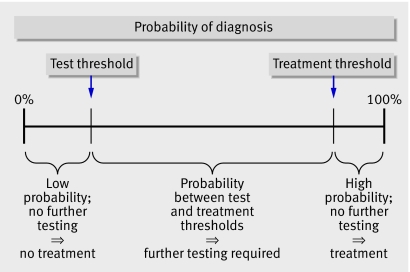Fig 2 Test and treatment thresholds. What clinicians expect of a good test is that results change the probability sufficiently to confirm or exclude a diagnosis. Tests, however, are altering only the probability of a disease of interest being present. If a test result moves the probability of the condition of interest to below the test threshold, this indicates that the condition is very unlikely, the downsides associated with any further testing and treatment for this condition outweigh any anticipated benefit, and no further testing or treatment for that condition should follow. If the test result increases the probability of disease to above the treatment threshold, this indicates that the condition is very likely, confirmatory testing that raises the probability of the condition further is unnecessary, and the anticipated benefits of treatment outweigh potential harms. If the pre-test probability is above the treatment threshold, further confirmatory testing that raises the probability further would not be helpful. If the pre-test probability is below the test threshold, further exclusionary testing would not be useful. When the probability is between the test and treatment thresholds, testing will be useful. Test results are of greatest value when they shift the probability across either threshold

An official website of the United States government
Here's how you know
Official websites use .gov
A
.gov website belongs to an official
government organization in the United States.
Secure .gov websites use HTTPS
A lock (
) or https:// means you've safely
connected to the .gov website. Share sensitive
information only on official, secure websites.
